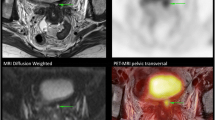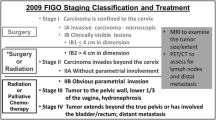Abstract
Purpose
Our purpose was to assess the diagnostic performance of positron emission tomography/computed tomography (PET/CT) and pelvic/abdominal magnetic resonance imaging (MRI) after concurrent chemoradiotherapy (CCRT) for posttherapy evaluation in patients with advanced cervical cancer.
Methods
Patients with cervical squamous cell carcinoma, either with advanced FIGO stage or with positive pelvic or para-aortic lymph node (PALN), received PET/CT using [18F]fluorodeoxyglucose and MRI including diffusion-weighted imaging between 2 and 3 months after CCRT completion. PET/CT were interpreted independently by two nuclear medicine physicians and MRI by two radiologists using the same scoring system. Active residual tumor was proven by pathological confirmation or disease progression on imaging studies within one year after CCRT and the disease regions were classified as local, regional, PALN, or distant. Patient-based and region-based comparison was performed using the receiver operating characteristic curve analysis.
Results
The study included 55 patients and 15 (27%) patients had active residual tumor. The diagnostic performance of PET/CT is significantly superior to that of MRI in patient-based analysis (P = 0.025) and in the detection of local (P = 0.045) and regional (P = 0.014) disease. The patient-based sensitivity, specificity, and accuracy of PET/CT are 60%, 100%, and 89% while those of MRI are 27%, 100%, and 80%.
Conclusions
PET/CT is superior to MRI for posttherapy evaluation in patients with advanced cervical cancer 2–3 months after definitive CCRT, mainly for the detection of residual local and regional disease. Patients with negative or equivocal results should be followed up regularly due to suboptimal sensitivities of imaging.



Similar content being viewed by others
References
Stewart B, Wild CP, (editors). World Cancer Report 2014. International Agency for Research on Cancer, WHO; 2014. Available from: http://www.thehealthwell.info/node/725845. Accessed: 31 May 2017.
Keys HM, Bundy BN, Stehman FB, Muderspach LI, Chafe WE, Suggs CL, et al. Cisplatin, radiation, and adjuvant hysterectomy compared with radiation and adjuvant hysterectomy for bulky stage IB cervical carcinoma. N Engl J Med. 1999;340:1154–61.
Morris M, Eifel PJ, Lu J, Grigspy GW, Levenback C, Stevens RE, et al. Pelvic radiation with concurrent chemotherapy compared with pelvic and para-aortic radiation for high-risk cervical cancer. N Engl J Med. 1999;340:1137–43.
Peters WA III, Liu PY, Barrett R, Gordon W Jr., Stock R, Berek JF, et al. Cisplatin, 5-fluorouracil plus radiation therapy are superior to radiation therapy as adjunctive therapy in high-risk, early-stage carcinoma of the cervix after radical hysterectomy and pelvic lymphadenectomy: report of a phase III intergroup study. Presented at Soc Gynecol Oncol 30th Annual Meeting, Gynecol Oncol. 1999;72:443.
Rose PG, Bundy BN, Watkins EB, Thigpen JT, Deppe G, Maiman MA, et al. Concurrent cisplatin-based radiotherapy and chemotherapy for locally advanced cervical cancer. N Engl J Med. 1999;340:1144–53.
Whitney CW, Sause W, Bundy BN, Malfetano JH, Hannigan EV, Fowler WC, et al. A randomized comparison of fluorouracil plus cisplatin versus hydroxyurea as an adjunct to radiation therapy in stages IIB-IVA carcinoma of the cervix with negative para-aortic lymph nodes: a gynecologic oncology group and southwest oncology group study. J Clin Oncol. 1999;17:1339–48.
Chemoradiotherapy for Cervical Cancer Meta-Analysis Collaboration. Reducing uncertainties about the effects of chemoradiotherapy for cervical cancer: a systematic review and metaanalysis of individual patient data from 18 randomized trials. J Clin Oncol. 2008;26:5802–12.
Liu FY, Lai CH, Yang LY, Wang CC, Lin G, Chang CJ, et al. Utility of 18F-FDG PET/CT in patients with advanced squamous cell carcinoma of the uterine cervix receiving concurrent chemoradiotherapy: a parallel study of a prospective randomized trial. Eur J Nucl Med Mol Imaging. 2016;43:1812–23.
Hong JH, Tsai CS, Lai CH, Chang TC, Wang CC, Chou HH, et al. Recurrent squamous cell carcinoma of cervix after definitive radiotherapy. Int J Radiat Oncol Biol Phys. 2004;60:249–57.
Herrera FG, Prior JO. The role of PET/CT in cervical cancer. Front Oncol. 2013;3:34.
Choi HJ, Ju W, Myung SK, Kim Y. Diagnostic performance of computer tomography, magnetic resonance imaging, and positron emission tomography or positron emission tomography/computer tomography for detection of metastatic lymph nodes in patients with cervical cancer: meta-analysis. Cancer Sci. 2010;101:1471–9.
Schwarz JK, Siegel BA, Dehdashti F, Grigsby PW. Association of posttherapy positron emission tomography with tumor response and survival in cervical carcinoma. JAMA. 2007;298:2289–95.
Levy A, Caramella C, Chargari C, Medjhoul A, Rey A, Zareski E, et al. Accuracy of diffusion-weighted echo-planar MR imaging and ADC mapping in the evaluation of residual cervical carcinoma after radiation therapy. Gynecol Oncol. 2011;123:110–5.
Kim HS, Kim CK, Park BK, Huh SJ, Kim B. Evaluation of therapeutic response to concurrent chemoradiotherapy in patients with cervical cancer using diffusion-weighted MR imaging. J Magn Reson Imaging. 2013;37:187–93.
Onal C, Erbay G, Guler OC. Treatment response evaluation using the mean apparent diffusion coefficient in cervical cancer patients treated with definitive chemoradiotherapy. J Magn Reson Imaging. 2016;44:1010–9.
Wang CC, Chou HH, Yang LY, Lin H, Liou WS, Tseng CW, et al. A randomized trial comparing concurrent chemoradiotherapy with single-agent cisplatin versus cisplatin plus gemcitabine in patients with advanced cervical cancer: an Asian gynecologic oncology group study. Gynecol Oncol. 2015;137:462–7.
Ho KC, Lin G, Wang JJ, Lai CH, Chang CJ, Yen TC. Correlation of apparent diffusion coefficients measured by 3T diffusion-weighted MRI and SUV from FDG PET/CT in primary cervical cancer. Eur J Nucl Med Mol Imaging. 2009;36:200–8.
Chou HH, Chang TC, Yen TC, Ng KK, Hsueh S, Ma SY, et al. Low value of [18F]-fluoro-2-deoxy-d-glucose positron emission tomography in primary staging of early-stage cervical cancer before radical hysterectomy. J Clin Oncol. 2006;24:123–8.
Ferrandina G, Petrillo M, Restaino G, Rufini V, Macchia G, Carbone A, et al. Can radicality of surgery be safely modulated on the basis of MRI and PET/CT imaging in locally advanced cervical cancer patients administered preoperative treatment? Cancer. 2012;118:392–403.
Páez D, Labonte MJ, Bohanes P, Zhang W, Benhanim L, Ning Y, et al. Cancer dormancy: a model of early dissemination and late cancer recurrence. Clin Cancer Res. 2012;18:645–53.
Acknowledgements
This study was financially supported by grants from the Chang Gung Memorial Hospital (CMRPG381141 and CMRPG381142), Taiwan.
Funding
This study was funded by Chang Gung Memorial Hospital (CMRPG381141 and CMRPG381142).
Author information
Authors and Affiliations
Corresponding author
Ethics declarations
Conflict of interest
The authors declare that they have no conflict of interest.
Ethical approval
All procedures performed in studies involving human participants were in accordance with the ethical standards of the institutional research committee and with the 1964 Helsinki Declaration and its later amendments or comparable ethical standards.
Informed consent
Informed consent was obtained from all individual participants included in the study.
Rights and permissions
About this article
Cite this article
Su, TP., Lin, G., Huang, YT. et al. Comparison of positron emission tomography/computed tomography and magnetic resonance imaging for posttherapy evaluation in patients with advanced cervical cancer receiving definitive concurrent chemoradiotherapy. Eur J Nucl Med Mol Imaging 45, 727–734 (2018). https://doi.org/10.1007/s00259-017-3884-0
Received:
Accepted:
Published:
Issue Date:
DOI: https://doi.org/10.1007/s00259-017-3884-0




